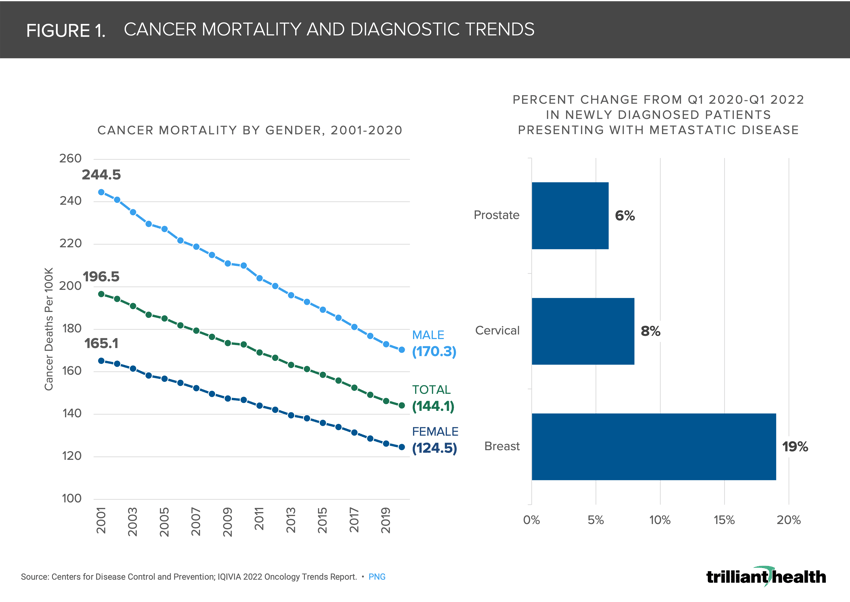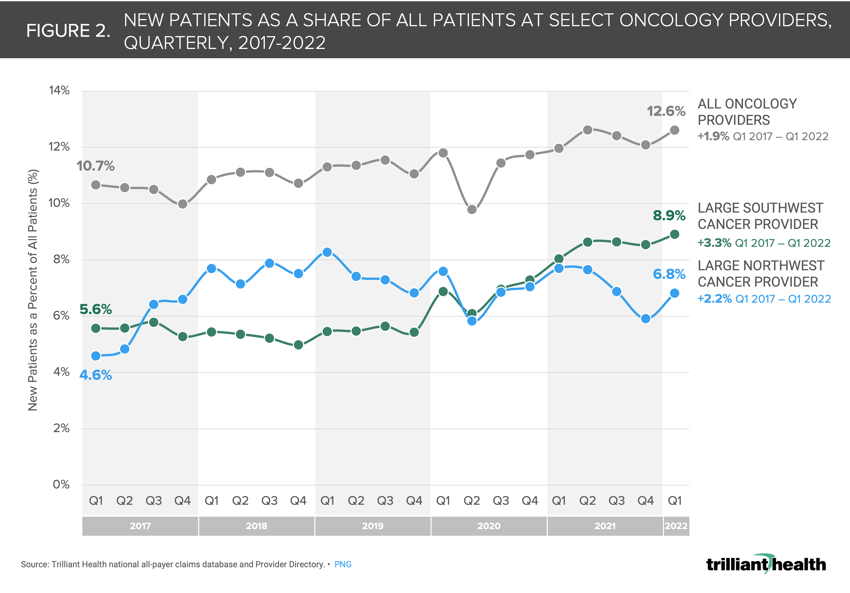The Compass
Sanjula Jain, Ph.D. | November 13, 2022Higher Patient Acuity Is Likely to Materialize Eventually
Key Takeaways
-
Despite stabilization in new cancer diagnoses and decreasing cancer death rates through 2019, the future trajectory of these trends remains in question given pandemic-era care behaviors.
-
While the cancer death rate declined by 27% between 2001 and 2020, survey data reveal a 19% increase in newly diagnosed patients with metastatic breast cancer, 8% with metastatic cervical cancer, and 6% with metastatic prostate cancer from Q1 2020 to Q1 2022.
-
Nationally, however, we observe the quarterly share of new patients stabilizing above pre-pandemic levels, up 1.9 percentage points in Q1 2022 compared to Q1 2017, signaling growth in prevalence of new post-pandemic cancer diagnoses.
Last month, the American Cancer Society, the Centers for Disease Control and Prevention, the National Cancer Institute, and the North American Association of Central Cancer Registries jointly released an annual report on the status of cancer in the U.S.1 Overall, cancer death rates decreased 2.3% per year (on average) for adult men and 1.9% per year (on average) for adult women from 2015 to 2019, and the rate of new cancers remained stable for men and increased slightly (0.2%) for adult women between 2014 and 2018. Despite the stable trends in new cancers and decreasing cancer death rates leading up to 2019, this report raised several questions of future trends given pandemic-era care behaviors.
Moreover, recent conversations with both health system executives and clinicians across the country report that an increasing number of younger patients without pre-existing conditions are presenting with more acute and unusual pathology. Because the magnitude of downstream clinical impacts attributable to changes in patient behaviors during the pandemic will take years to manifest, it is imperative to analyze the data “in real time” to detect shifts in patient acuity as early as possible.
Decreasing Cancer Mortality May Be Jeopardized by Care Delays
Across cancer types, preventive screenings have declined since 2017.2 If the decline in incidence of associated cancer diagnoses over the same period results from underdiagnosis, then it is likely that patients will increasingly receive an initial diagnosis of a more advanced stage cancer.
While the total cancer case count is increasing, overall incidence of cancer remained relatively flat between 2014 and 2018.3 The cancer death rate declined by 27% between 2001 and 2020, from 196.5 to 144.1 deaths per 100K population (Figure 1). However, the combination of delayed screening and increasing rates of incident metastatic disease may jeopardize these gains. Survey data revealed a 19% increase in newly diagnosed patients with metastatic breast cancer, 8% with metastatic cervical cancer, and 6% with metastatic prostate cancer from Q1 2020 to Q1 2022.4

Early Signals of Increasing Cancer Prevalence
Anticipating and preventing more acute pathology (e.g., late-stage cancers, end-stage renal disease, heart failure) is challenging since our public health and healthcare delivery systems are more reactive than proactive. However, the apparent shifts in healthcare utilization in recent quarters, such as reduced screenings and shifts to lower-acuity care settings, should be concerning to many health economy stakeholders.5
Analytic Approach
To further examine the early signal for potential changes in cancer prevalence, we analyzed quarterly patient volumes from Q1 2017 through Q1 2022 across all payers, associated with 1) a large Southwest oncology provider, 2) a large Northeast oncology provider, and 3) all oncology providers available in our Provider Directory. We analyzed new patients associated with each provider segment as a share of all patients seen by those providers each quarter.
Findings
Overall, there is an upward trend from Q1 2017 to Q1 2022 in the share of new patients associated with the Southwest provider (+3.3 percentage points), Northeast provider (+2.2 percentage points) and oncology providers nationally (+1.9 percentage points) (Figure 2). While the share of new patients declined in Q2 2020 amid the COVID-19 pandemic, the share of new patients associated with the Southwest oncology provider has increased quarter-over-quarter since the decline, increasing approximately two percentage points in Q1 2022 as compared to Q2 2020. The growth in new patients at the Northeast oncology provider is not as consistent, reinforcing the geographic variation in care trends. Nationally, however, we observe the quarterly share of new patients stabilizing above pre-pandemic levels, signaling growth in prevalence of new post-pandemic cancer diagnoses.
 These findings, in tandem with other data trends, such as recent investments by life sciences companies and the slow return to “routine” preventive care, may be a harbinger of more acute pathology and burden of disease, particularly in oncology.6,7 If so, the implications for every stakeholder from patients to providers and payers and life sciences will be significant. Future research is needed to quantify whether the pandemic is going to reverse past improvements to rates of new cancers and the cancer death rate.
These findings, in tandem with other data trends, such as recent investments by life sciences companies and the slow return to “routine” preventive care, may be a harbinger of more acute pathology and burden of disease, particularly in oncology.6,7 If so, the implications for every stakeholder from patients to providers and payers and life sciences will be significant. Future research is needed to quantify whether the pandemic is going to reverse past improvements to rates of new cancers and the cancer death rate.
Thanks to Kelly Boyce, Katie Patton, Cindy Revol, and David Taylor for their research support.
- Specialty Care
- Disease Burden
You are currently viewing a free preview of our premium studies. To receive new studies weekly, upgrade to Compass+ Professional.
Sign UpSee more with Compass+
You are currently viewing the free version of this study. To access the full study, subscribe to Compass+ Professional for $199 per year.
Sign Up for Compass+